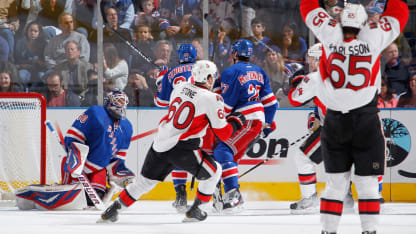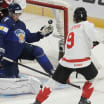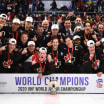Stone silences critics, makes mark with Golden Knights
Forward overcame early skating issues to become Selke Trophy finalist last season

McCrimmon, now the general manager of the Vegas Golden Knights, held the same position with Brandon of the Western Hockey League, and had spent the offseason trying to sign Mark Stone, who was 16 years old and had a father leery of sending his son to play in the rough-and-tumble WHL.
But the pause wasn't for the usual reasons.
"He just couldn't believe it: With that skating?" McCrimmon said, still amused at Rob Stone's reaction. "That's how he said it, 'with that skating?'"
Rob Stone couldn't quite comprehend it. He had seen his kid skate his whole life and, well, with that skating?
"What was always interesting, and sort of comical in a way, is unlike most dads, who might have an overinflated opinion of how good their son is, it was me convincing Rob how good Mark was and, in fact, that he was ready to be a full-time WHL player," McCrimmon said. "So, I have reminded him of that over the years."
Though Rob recalls the words slightly differently -- "My first words, I said, 'I don't think he can skate well enough to play in that league right now' -- the idea was the same, the concept that Mark had quite a few key hockey attributes, skills and talents, but that one? That one he was going to have to overcome."
And he has.
Over his seven seasons in the NHL, starting with the Ottawa Senators and moving on to the Golden Knights after a trade on Feb. 25, 2019, Stone has vastly improved his skating, transforming from a slow kid into one of the sneakiest stars in the League, a player who sees the game as well as anyone, takes the puck away better than anyone, and who maybe -- finally -- is getting his due.
VGK@FLA: Stone ties career-high with five points
Which even his dad can admit now. Asked if he thought people might still underestimate Mark at times, despite the eight-year, $9.5 million average annual value contract signed on March 8, being a finalist for the Selke Trophy last season, scoring 12 points (six goals, six assists) in seven Stanley Cup Playoff games last season or his 53 points (20 goals, 33 assists) in 57 games this season, Rob Stone said, "Well, they might. They look at the way he skates and think, 'Oh, he can't get there.' Well, good luck."
Because, as they soon find out, he almost always can.
"I don't think there's any guys in this League who play the way I play," Mark Stone said. "I wish I could be Sidney Crosby; I wish I could be Connor McDavid. But ultimately, I can't skate like Connor McDavid. I'm not as skilled as Sidney Crosby. But there are probably things that they see that I do that they wish they could do."
\\\\
It started in the basement, and on the driveway, and on the frozen ponds of Winnipeg. And every Saturday was "Hockey Night in Canada" and the Stone family -- including sons Mark and Michael, now a defenseman for the Calgary Flames -- would order pizza, and ready themselves for a double feature.
"Most of the time my dad would be down there, watching hockey," Mark Stone said. "Me and my brother would be fooling around behind, watching, playing mini sticks, playing hockey. Once the game would come on, we'd watch. Intermission hit, we'd be right back behind the couch playing mini sticks."
He started on skates at 3, a fact that Rob Stone still beats himself up about, taking on some of the fault for the skating deficiencies Mark has endured.
"I blame his skating on his mum and I, because we let him go out on skates when he was too young and not ready to skate, but he would get on the ice and run on skates," he said. "And he never really grew until he was 12, 13. He was usually kind of small, a bit smaller on the ice. He couldn't outrun anybody. So, he had to control the puck."
He had to learn the game better than anyone. He had to see the game better than anyone.
Fortunately for him, he'd been training for it already.
"Most kids like to watch cartoons," Rob said. "But not Mark. Mark watched hockey tapes."
His mom, Jackie, would take the boys every Tuesday and Thursday to "Mom and Tot" skates, 1 to 3 p.m. at the local rink. All the neighborhood kids would be there, someone would bring hot chocolate or cookies, and it was, as Rob put it, "a free for all. They just opened up the arena and let them all skate."
They only stopped when Mark was in the first grade, and finally had to go to school in the afternoons.
Still, though, there were the outdoor rinks, where Mark got his fix of the hockey that helped him grow to be what he would later become, that honed his senses and his anticipation and his hockey brain.
"There's no structure, no systems, you just go out and have some fun," he said. "I played hundreds and hundreds of two-on-twos -- there's no hitting, there's no slashing, just all trying to dangle. The other side of the game. Stick lifts and trying to steal the puck.
"These are the kind of things that I look back on now -- I probably didn't realize when I was 10 years old, it's helping me with my hockey."
VGK@OTT: Stone nets wraparound in return to Ottawa
It was a foundation that would pay dividends when Mark finally got to the WHL, when McCrimmon could see what was special about the kid he'd taken in the fifth round with the No. 92 pick of the 2007 WHL draft.
And it was more than the GM had anticipated.
"There were a lot of aspects of his game that were really good," McCrimmon said. "You could tell what served him well, but it was going to be about his skating. It took more time to realize just how big a contributor to his game hockey sense was, and then you could really start to feel like you had a real good chance to turn [him] into a top player."
\\\\
He just needed to fix that skating.
When Stone got to Ottawa, after being selcted in the sixth round (No. 178) of the 2010 NHL Draft, he worked with a power skating coach, he worked on his strength, he did the best to fix what needed fixing in his game.
Though, even then, it was evident what he could bring - with 106 points (37 goals, 69 assists) for Brandon in 2010-11 and 123 points (41 goals, 82 assists) the following season.

© Scott Levy/Getty Images
Paul MacLean, his first coach with the Senators and now an assistant with the Columbus Blue Jackets, saw it in Stone's first NHL game, on April 21, 2012, when he debuted in Game 5 of the Eastern Conference First Round against the New York Rangers at Madison Square Garden.
That night, Stone sent a pass to Jason Spezza for the game-winning goal that MacLean calls "pretty good for a guy that a week ago was playing in the Western Hockey League for the Brandon Wheat Kings.
"That moment, you say, well, this guy has a chance to be special."
He still had work to do, but MacLean could see it. He could see it.
"His abilities, his hockey sense, his stick work, the way that he was able to play the game, you could tell that he had the chance to be a very special player," MacLean said. "The only thing that could possibly hold him back would be the injuries or his skating ability, but in Ottawa with the power skating people and the off-ice development people, he really worked hard at his game and his skating.
"You could see from there, once that fell into place, that he had the ability to be a very special player, and he certainly turned out that way."
They took a hard look at his edges and his starts and on getting up to his full speed as fast as possible. They added to his strength. They rebuilt the parts they could rebuild, knowing that his mind was already where it needed to be.
"My stride wasn't great," said Stone, who has 375 points (148 goals, 227 assists) in 441 NHL games. "It wasn't horrible. But I think I went to camp my first year, I was 6-foot-3 and I was 180 pounds. There wasn't a lot of strength. I was weak, pretty much all over my body. In the summer I was a golfer, I wasn't a hockey player."
ARI@VGK: Stone buries second goal off great assist
The first 20 or 30 seconds in a shift back then, Stone recalled that his legs would be shaking. Now, he said, he's comfortable through a whole shift, a whole game, playing 19:33 per game, as he is this season, whatever his team needs.
He's not graceful or fast. He's not pretty or quick. But that stick? That stick is a thing of beauty.
That stick is the reason that Stone yet again leads the NHL in takeaways, with 73 this season, six more than defenseman Jaccob Slavin of the Carolina Hurricanes, who has 67. Since 2014-15, his first full season, he leads the NHL with 576 takeaways; center Ryan O'Reilly of the St. Louis Blues is a distant second with 422.
"When people look at him from the outside, he probably doesn't look like a good skater," teammate Paul Stastny said. "He's got the bad style. In the summertime I skate with so many players that look like All-Star players and then when you put them in a game five-on-five and you have to think the game, all of a sudden you realize how much better he is than everyone else."
Stone was a finalist for the Selke last season, the first time that a wing had been part of what is usually a centers-only club since Jay Pandolfo was a finalist in 2006-07. It was an appreciation for a game that has gotten a wider audience in Las Vegas, plus a bump from that attention-grabbing trade and contract.
And though it's a different NHL than when Pandolfo was recognized for his defensive prowess as a wing on a checking line with the New Jersey Devils, the now-assistant for the Boston Bruins can see why Stone gets the accolades, coupling his offensive talent with a knack for being in the right place at the right time.
"He does it more on disrupting plays, even in the offensive zone where he steals pucks or reloading back to the neutral zone, he steals a lot of pucks that way," Pandolfo said. "He's just hard to play against. He has a great stick. I think for a winger it's definitely tougher to get recognized, but he's so good at it, he's so smart, and people recognize that.
"You look at four-time winner Patrice Bergeron] too, he knows what's going to happen before it happens. Stone's similar. He baits guys in and next thing you know, he steals the puck from them or steals the pass."
It's what endears him to teammates, particularly Stastny, who feels he's found a kindred spirit with whom he can either break down a play in detail, or not say a single word -- and still know exactly what Stone is thinking and doing.
"It's the little things he does," Stastny said. "It's all the little things that add up to big plays."
---
Listen: [New episode of NHL @The Rink

















